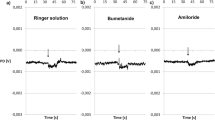Abstract
DC current-voltage relationships and sodium ion transport measurements for human allograft skin immersed in saline buffers have been determined using a four terminal potentiometric method and diffusion cells of our own design. About three-fourths of the skin samples were deemed suitable for study on the basis of their high resistivities and similar j–V characteristics. Most of these samples yielded sodium ion permeability coefficients less than or equal to those reported for human skin in vivo. The current–voltage relationship in these tissues was time dependent, highly nonlinear, and slightly asymmetric with respect to the sign of the applied potential. Skin resistance decreased as current or voltage increased. For current densities less than 15 µA/cm2 and exposure times of 10–20 min, this decrease was almost completely reversible; at higher current densities, both reversible and irreversible effects were observed. The overall dependence of current on voltage was nearly exponential and was satisfactorily described by an equation of the form j ∼ sinh V. Diffusion potentials, sodium ion membrane transference numbers, and sodium ion flux enhancement factors during iontophoresis were measured for skin immersed both in normal saline solutions and in saline solutions of differing concentrations. The sign of the diffusion potentials and the value of the sodium ion transference number (0.51 in normal saline at pH 7.4) indicated a weak permselectivity of the skin for transport of sodium ion versus chloride. At a current density of 71 µA/cm2 and transmembrane potentials in the range of 1.1–1.6 V, the flux enhancement for sodium ion was three to five times greater than that predicted for an uncharged homogeneous membrane according to electrodiffusion theory. For transmembrane potentials less than 0.17 V, agreement of this theory with the data was better but still incomplete.
Similar content being viewed by others
Explore related subjects
Discover the latest articles and news from researchers in related subjects, suggested using machine learning.REFERENCES
A. K. Banga and Y. W. Chien. J. Control. Release 7:1–24 (1988).
R. R. Burnette and D. Marrero. J. Pharm. Sci. 75:738–743 (1986).
B. R. Meyer, W. Kreis, J. Eshbach, V. O'Mara, S. Rosen, and D. Sibalis. Clin. Pharmacol. Ther. 44:607–612 (1988).
G. B. Kasting and J. C. Keister. J. Control. Release 8:195–210 (1989).
R. J. Scheuplein. In A. Jarrett (ed.), The Physiology and Pathophysiology of the Skin, Vol. 5, Academic Press, London, 1978, pp. 1659–1752.
R. T. Plessinger. Personal communication, Ohio Valley Skin and Tissue Center.
J. Ostrenga, C. Steinmetz, and B. Poulson. J. Pharm. Sci. 60:1175–1179 (1971).
R. C. Weast (ed.). Handbook of Chemistry and Physics, 62nd ed., CRC Press, Boca Raton, FL, 1981, p. D-232.
G. B. Kasting, E. W. Merritt, and J. C. Keister. J. Membrane Sci. 35:137–159 (1988).
A. Finklestein and A. Mauro. In Handbook of Physiology, Section 1: The Nervous System, Vol. I, Am. Physiol. Soc., Bethesda, MD, 1977, Chap. 6, pp. 161–213.
R. T. Tregear. Nature 205:600–601 (1965).
R. T. Tregear. J. Invest. Dermatol. 46:16–23 (1966).
G. B. Kasting and L. A. Bowman. In preparation.
A. J. Bard and L. R. Faulkner. Electrochemical Methods: Fundamentals and Applications, Wiley, New York, 1980, pp. 87–118.
J. C. Keister and G. B. Kasting. The mechanism of iontophoresis, Proceedings of NIH conference on physical and chemical enhancement of drug transport through skin, Bethesda, MD, May 23–24, 1988.
P. R. Bevington. Data Analysis for the Physical Sciences, McGraw-Hill, New York, 1969, p. 235 (Marquardt algorithm).
R. R. Burnette and B. Ongpipattanakul. J. Pharm. Sci. 76:765–773 (1987).
R. C. Weast (ed.). Handbook of Chemistry and Physics, 65th ed., CRC Press, Boca Raton, FL, 1984, pp. D171–D173.
J. C. Keister and G. B. Kasting. Unpublished results.
T. J. Franz. J. Invest. Dermatol. 64:190–195 (1975).
Author information
Authors and Affiliations
Rights and permissions
About this article
Cite this article
Kasting, G.B., Bowman, L.A. DC Electrical Properties of Frozen, Excised Human Skin. Pharm Res 7, 134–143 (1990). https://doi.org/10.1023/A:1015820600672
Issue Date:
DOI: https://doi.org/10.1023/A:1015820600672




